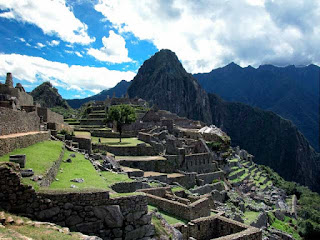July 25, marks the 100th anniversary of the discovery of the "Lost City" of Machu Picchu.
The Spaniards never found Machu Picchu, even though they suspected its existence, thus the Intihuatana stone and its resident spirits remain in their original position. The mountain top sanctuary fell into disuse and was abandoned some forty years after the Spanish took Cuzco in 1533. Supply lines linking the many Inca social centers were disrupted and the great empire came to an end.
Source: Info Please
Machu Picchu sits 9,090 feet above sea level and 300 miles south of Lima. It is one of the most visited places in South America with 250,000 visitors per year. Four years ago it was voted one of the Seven Wonders of the World in a global Internet poll.
After Bingham's discovery, National Geographic magazine awarded him a $10,000 grant that was matched by Yale University where he was a professor of history and politics. This money afforded him three more expeditions to the site, which also led to the taking of 44,000 pieces and sparked a long-standing controversy between him, Yale, and Peruvians. This past March, 366 of those pieces were returned in time for the 100th anniversary celebration.
MY EXPERIENCE AT MACHU PICCHU
I visited Machu Picchu in March 1986 as a W.K. Kellogg National Leadership Fellow. It was a memorable experience, mostly because I felt I touched the hand of God here and understood my smallness compared to the immensity of God's creation. To see an excerpt from my journal and a more expanded story with photos, check out my blog: http://olgabonfiglio.blogspot.com/2011/07/travelogue-100-year-anniversary-of.html







